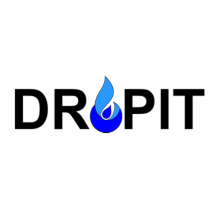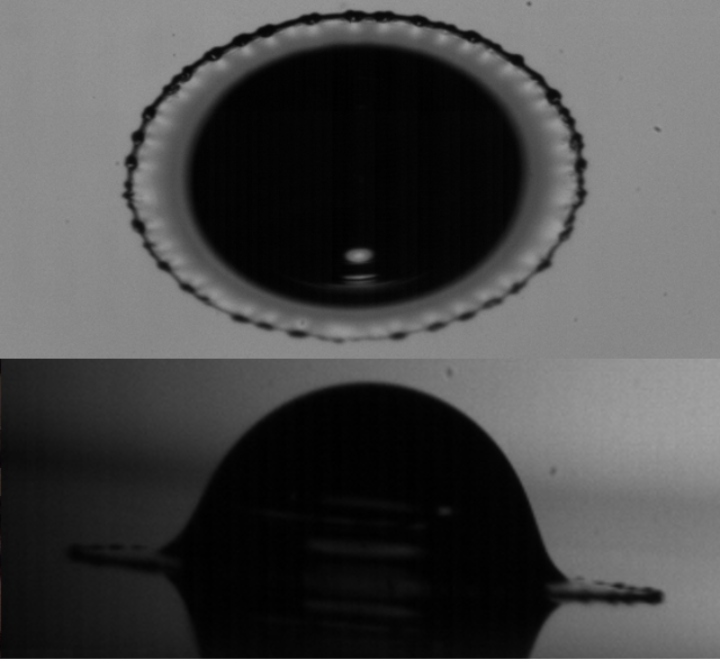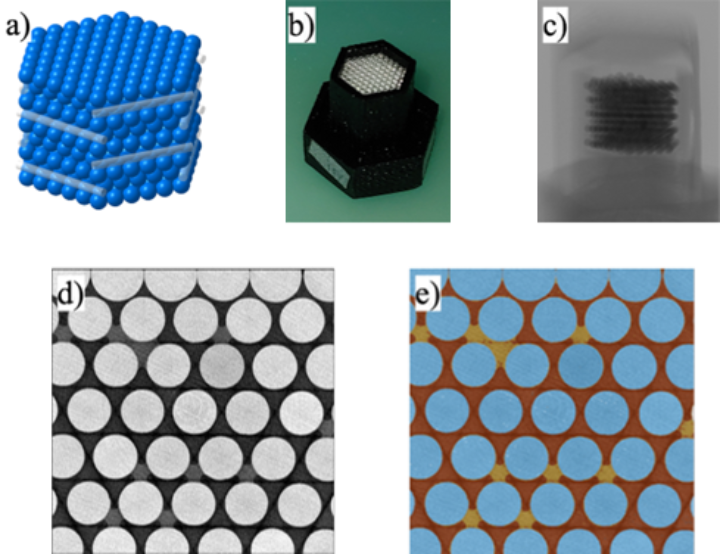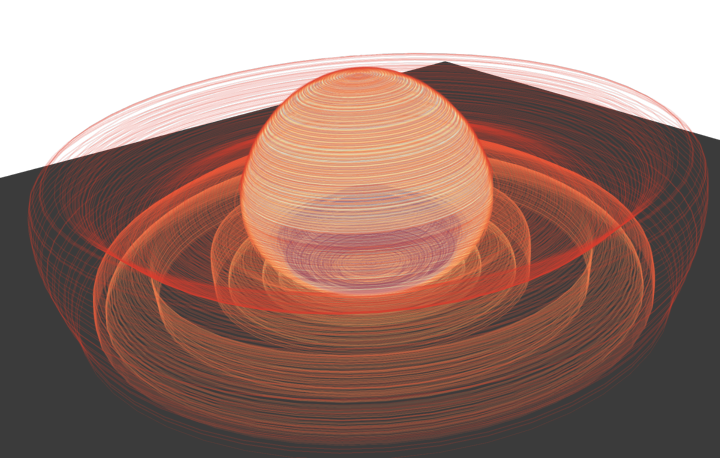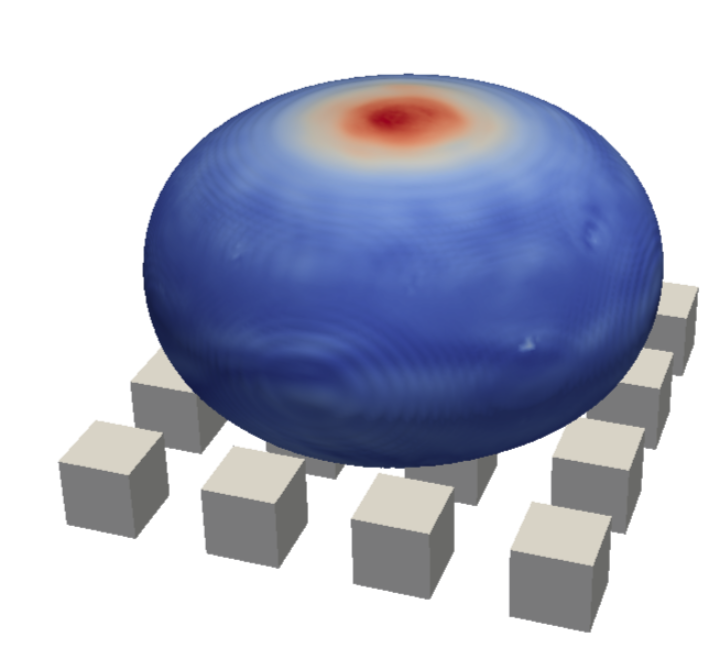SP-B1: Droplet collisions with solid superhydrophilic surfaces
Droplet-wall interactions can be observed everywhere in daily life such as in raindrops hitting the ground or windows of cars and buildings. In technical systems, drop impingement on surfaces is, for instance, of relevance for spray painting or spray cooling processes. In these cases, the wetting and spreading behavior of the droplet liquid can determine the coating quality or the cooling efficiency, respectively. Another aspect is the formation of thin liquid films on superhydrophilic surfaces after droplet impacts, which are the reason for self-cleaning effects of such surfaces. These surfaces are structured on a microscopic scale or even porous.
The motivation for this project is to understand the physical processes and to be able to predict the behavior of the droplet liquid, when the contact angle between droplet liquid and solid wall is very small, meaning that the surface shows superhydrophilic behaviour. In this case the wetted area is very large and may result in an increase of the heat transfer between droplet liquid and wall or the formation of a thin liquid film.
The distribution of the droplet liquid on the solid surface during and after a droplet impact is an essential objective of this project. This is important for the quality of spray coatings or the heat transfer in spray cooling processes as well as for the formation of a thin liquid film on superhydrophilic surfaces. It is obvious that in such a situation the contact angle plays an important role. Wider spreading of the droplet liquid is expected, when the contact angle is very low, like for superhydrophilic surfaces.
To investigate the effects of the micro-structures on the surface, they will be systematically altered. The surface structures will be analyzed and optimized in order to enhance the superhydrophilic behavior. Experiments will be performed for different droplet velocities and impact angles onto structured walls with different micro-structured surfaces, including porous walls. The experimental setup to study oblique impacts will be developed in cooperation with SP-C2. The impact process will be observed, like in the first funding period of the project, by a high-speed camera from up to three perspectives simultaneously. In the second funding period
- The influence of different wetting behaviors on the outcome of droplet impacts on smooth, structured and porous surfaces will be investigated. The interaction of two droplets impacting simultaneously or in quick succession will be emphasized.
- Using micro-PIV and micro-PTV techniques, the velocities parallel to the wall will be measured during the spreading process. A strong cooperation with SP-C5 will take place for this work package, as the method was developed in the scope of SP-C5 in the first funding phase of DROPIT.
- As a next step, experiments on smooth and microstructured, heated superhydrophilic surfaces will be performed. The goal will be to investigate the temperature distribution, the heat transfer and changes in film behaviour. Here the effect of microstructured surfaces on the heat transfer will be investigated in detail. For this, the prism will be heated to a constant temperature. Temperature distributions will be observed via infrared thermometry.
- Lastly, the new method for film thickness measurements (LPSM) will be further developed in cooperation with SP-C5 for micro-structured surfaces. In the scope of Micro-PIV/PTV measurements on smooth surfaces, possible applications of the method will be investigated.
SP-B2: Drop impact/deposition onto micro-structured hydrophobic and superhydrophobic surfaces
The effect of water repelling, like the self-cleaning mechanism of lotus leaves, is named superhydrophobicity, i.e. the enhancement of hydrophobic properties as a result of surface-textures/roughness. Biomimetic materials are generally manufactured by developing complicated micro- and nano-reliefs controlling the surface chemistry. Wetting occurring on rough and chemically heterogeneous surfaces is described by the Cassie-Baxter and Wenzel models and their extensions developed for hierarchical surfaces. The multiscale topography of the relief strengthens the water repellency of surfaces and enhances the stability of the Cassie wetting state. Several wetting-transition mechanisms are proposed based on the energy barrier or the critical Laplace pressure. Despite many efforts, there are still some discussions on the droplet wetting mechanism. Commonly used parameters reporting surface’s superhydrophobicity (apparent contact angle and contact angle hysteresis), do not reflect the liquid-pressure stability of the surface. Hence, understanding the physical mechanism of wetting is still lacking, but crucial for the design of efficient superhydrophobic materials.
The main objective of SP-B2 is to visualise the three-phase contact line and the bilateral liquid-gas interface between patterns for different wetting states and to contribute to shed light on the impact of the surface topography on wetting transition. Wetting transition will be induced by two modes: (a) evaporation; (b) providing energy to the drop by impacting it from some height. Micro-CT will be used to generate 3D images of the drop-substrate system. Both can be distinguished due to their different X-ray absorbing capacity. Wetted and non-wetted surface fractions will be determined and confronted to wetting regimes and models. The penetration within the surface micro-structures will be analysed over all the droplet contact area as a function of deposit/impact condition and wetting transition mode. The following tasks are envisioned:
- Wetting transition on hydrophobic and superhydrophobic surfaces with well-defined and characterised topography. Experiments will be performed with different micro-patterned surfaces. The gas-liquid interface within the textures will be visualised by micro-CT. The corresponding curvatures will be calculated and related to the wetting state.
- Directly experimental evidencing of the Cassie impregnating state.
- Experimental study of the dynamics of the triple line under wetting transition. The so-called 4D micro-CT, time-dependent, spatial 3D inspection, will be applied.
- Wetting transition for various organic liquids. For this purpose, the surface tension will be systematically varied.
SP-B3: Characterization of porous media by X-ray micro computed to-mography
The determination of solid/fluid interfaces in a multi-phase flow system is crucial for several thermodynamic and fluid mechanic phenomena. Particularly its visualization in porous media is generally not possible for opaque systems, requiring full optical access from outside. However, for complicated internal material structures, which are not opaque, this approach is hardly possible. The ongoing sub-project is greatly improving the quality of the experiments inherent in these visualizations in order to provide studies based on the modelling of evaporation and mass transport. The technique used so far has been substantially based on tomographic reconstructions, based on a large number of micrometric resolution radiographs obtained with a specific instrumentation (X-ray micro-CT). The limiting factor in this method still is the duration of the scanning of the experiment because, e.g. the evaporation process requires a rather rapid scan, incompatible with filtered back-projection (FDK) reconstruction techniques. This is because it is required to satisfy the Nyquist-Shannon sampling theorem, forcing to increase the number of projections (taken from a full angular view, over a total 360° rotation of the specimen) as the investigation resolution decreases. Such a requirement is mandatory for the characterisation of multi-phase interfaces in detail. The picture shows an example of a multi-phase experiment in a porous reference medium. Its scanning required 3600 radiographs (for a total scanning time of 138 minutes) during which (theoretically) no movement inside the sample (especially for the evaporating fluid part) would be allowed. So, the analysis procedure, which has been practised in FP1 needs to be extended in order to cope with these restrictions. Here, a novel solution is possible by an algebraic reconstruction, which requires a reduced number of radiographs, thus compressing the scanning time and allowing an easier study of the above-mentioned phenomena. Moreover, solving this problem has an enormous effect and value on different research fields, also outside of this sub-project, thus motivating scientific interest in its application.
The overall aim of SP-B3 is to apply the aforementioned poly-DART X-ray micro-computed tomography reconstruction algorithm, developed within the ASTRA toolbox, to experimental investigations which are needed for studying the evolution of multi-phase interfaces. The technique proposed in will allow to considerably reduce the number of projections and, therefore, to reduce the acquisition time of a complete scan. On the other hand, it will be necessary to provide information on the characterisation of the porous medium: a series of preparatory experiments will be planned to know the attenuation coefficients of the materials, the nominal geometries before wetting and the reconstruction parametrizations (i.e. the emission spectrum of the X-ray source). The envisioned objective can be summarized as:
- At first, comparisons between the FDK and poly-DART reconstructions on typical pore microscale models (as needed in DROPIT) will be carried out. This will be done initially under multi-phase steady state conditions. Involved media will be characterised to obtain the necessary a-priori knowledge for poly-DART.
- After this, an extension to unsteady processes, e.g. evaporation, is envisaged.
- Experimental investigation of pore-scale fluid displacement in multi-phase systems applying the poly-DART.
SP-B4: Towards asymptotic preserving all-speed simulations for the interaction of droplets with textured walls
The impact of single droplets onto surfaces bears a wealth of interesting effects that comes along with widely different flow regimes. The interaction dynamics is governed by incompressible, weakly compressible or even fully compressible regimes in the liquid droplet phase and the surrounding gaseous phase. With increasing velocity rebound pressure waves turn into compression shock waves sensitively influencing the lateral wave jetting. The droplet might entrap an air bubble subject to strong compressibility effects. These phenomena have been studied for isolated flow regimes and flat perfect walls, but very little has been done for arbitrary regimes and textured (superhydrophobic) walls, when micro-level structures affect the macroscopic flow field. The sub-project B4 aims to provide mathematical models and efficient numerical methods to describe the dynamics for such walls for a possibly wide range of compressibility indices. From the methodological point of view, we will rely on new diffuse-interface models that are combined with a Heterogeneous Multiscale Method (HMM) providing effective boundary conditions for micro-structured walls.
The overall objective of this project is the development of a mathematical model for the dynamics of droplet impact on textured surfaces that covers a wide range of compressibility indices including its efficient and reliable numerical simulation. To achieve this goal, we will pursue the following tasks:
- Development of diffuse-interface models applicable to all-speed flow regimes. As the basic mathematical approach we consider in this project a diffuse-interface ansatz for the dynamics of the flow in the droplet and in the ambient gas. In previous works we have developed such a model for two viscous and compressible phases with the diffuse interface governing the droplet surface. To be precise, the model consists of the compressible Navier-Stokes equations coupled with a Cahn-Hilliard equation for the phase field parameter. Formally, the model collapses for vanishing Mach number into the incompressible diffuse-interface approach. The first step of the project is the generalisation of both approaches to the diffuse coupling of an incompressible with a compressible dynamic. As basic discretisation method we will use a spatially adaptive LDG method of higher order. When dealing with a wide range of Mach numbers the efficiency of the numerical time-stepping strategy becomes crucial. We will cope with this difficulty by transferring recent asymptotic-preserving schemes for the one-phase case. The method will be tested and validated for the drop impact on a perfect rigid wall with flat geometry. Note that we rely here on a Navier-Stokes model for the bulk flow since a computationally preferable inviscid flow model would not allow to integrate the effective boundary conditions, which will be developed in the third subtask.
- Direct Numerical Simulations. The extreme geometry of a realistic textured (superhydrophobic) wall (in the nm scale) does not permit a direct numerical simulation with a flow model as described above. Nevertheless, we plan to test the diffuse-interface model on a wall with a small number of riffles of varying depth and distances. These tests should first give an impression about the fluid dynamics’ changes due to different regimes and non-perfect wall structures. Second, they will serve as benchmarks for the computations with the heterogeneous multi-scale method (see next subtask). Third, we are interested in the comparison with purely incompressible or purely compressible approaches.
- Development of a Heterogeneous Multiscale Method (HMM). A numerically practicable approach could rely on homogenised, effective boundary conditions that are finally applied on a simple macroscopic boundary, i.e. a flat surface. For incompressible flows rigorous homogenisation has been achieved for simplified settings, which results in effective Navier-type boundary conditions. For a first attempt for compressible flows we refer to Deolmi et al., but a closed form of the effective boundary conditions appears hard to derive. The Navier-type conditions contain still unknown parameters to describe the effective slip. The slip depends on the geometry and on the micro-scale flow close to the textured wall. We consider now the flow in the perfect domain with the diffuse-interface model as macro-scale model and a possibly simplified flow model in the textures as micro-scale model. Using the adaptive procedure, we will perform an efficient numerical upscaling that leads to the final HMM. The method will be applied to obtain numerical simulations for selected experiments in SP-B1 and SP-B2.
SP-B5: Numerical computation for drop impact on textured surfaces
The interaction of droplets with a solid surface is encountered in numerous technical applications and natural processes. In recent years, increased interest has been set on textured surfaces with hydrophobic or superhydrophobic behaviour. Flat surfaces have been arbitrarily classified as hydrophobic when a water droplet yields a contact angle larger than 90 deg., hydrophilic otherwise. Superhydrophobic surfaces normally yield a contact angle larger than 135 deg. However, there is today agreement that the sole use of a contact angle is insufficient to describe the wettability of a surface. Recently, several publications have studied textured and coated surfaces with superhydrophobic behaviour. Still only limited numerical work has been done to understand the fundamental physical mechanisms taking place for a drop impact on such surfaces. With increasing computer capabilities over the last few years, it is now possible to carry out highly resolved Direct Numerical Simulations (DNS) of multi-phase flows. This makes it e.g. possible to analyse now drop impacts on textured surfaces (with texture geometries in the μm-scale). Thus, this project aims to numerically study in detail drop impact and wetting behaviour on a textured surface with different micro-structures on the surface.
The objectives of this project are based on the numerical framework and the multi-phase code that has been developed so far at the Institute of Aerospace Thermodynamics (ITLR). This code will be applied to the simulation of non-spherical and oscillating droplets. The further development includes the extension to multi-component droplets, which needs novel evaporation models for multiple evaporants. A close cooperation to experimental and theoretical results will be used to validate the numerical modelling. The objectives can be formulated as the following sub-goals:
- The aim of SP-B5 is the numerical prediction of a single droplet impinging on a surface. The surface will be textured and different structures will be studied. It is obvious, that the contact angles and the contact line dynamics play an important role for this process. For the simulation of multi-phase flows, the in-house 3D CFD code Free Surface 3D (FS3D) has already been successfully used. FS3D solves the Navier-Stokes and the energy equations for incompressible flows with arbitrary free surfaces using DNS. Thereby, the flow field is computed by solving the governing equations for conservation of mass, momentum and energy. The surface tension is handled as a volume force that acts on every cell containing an interface and is computed by advanced models, avoiding the occurrence of parasitic currents.
- To describe the interface, the Volume-of-Fluid (VOF) method by Hirt and Nichols is used, where an additional variable, specifying the liquid volume fraction is introduced and transported by a separate transport equation. Thus, the multi-phase flow can be treated as a single phase flow with varying density and source terms, including the jump conditions at the interface. The equations are discretized by a finite volume scheme and the calculation of the numerical fluxes of the volume transport is based on a piecewise linear interface calculation method (PLIC) proposed by Rider and Kothe, thus ensuring a sharp interface and suppressing numerical dissipation of the disperse phase. The resulting pressure Poisson equation is solved by an optimized multi-grid solver that is extremely efficient and allows respectable simulation times on high performance computers such as the Cray-XE6 platform at the High Performance Computing Centre in Stuttgart (HLRS). Computations will be carried out first for single droplet impingement with droplet diameters of about 1 mm on larger textured surfaces with pillar and rib structures. These structures will be in the order of 100 μm in height with spacing of about 200 - 300 μm. Here DNS approaches are investigated and the calculations are validated together with SP-B1 and SP-B3. Also subgrid models for the dynamics of the three phase contact line will be implemented into FS3D and will be tested. This will also been done for various wall tempera-tures. Then smaller surface textures in the order of 20-30 μm will be investigated. Here modifications of the used contact angle models and/or the model for the contact line dynamics has to be looked at for superhydrophobic coatings. This will be done in cooperation with the experimental projects SP-B1, SP-B2 and SP-B3.
SP-B6: Coupled free flow-porous media flow processes including drop formation
Droplet formation at the interface between a porous medium and the adjacent free flow domain occurs in many technical applications such as water management in fuel cells, membrane emulsification, membrane filtration and thermal insulation of buildings. Droplet formation tends to increase the complexity of the system by turning a simple interface to a complex interface, which not only handles the exchange between the free flow and the porous medium, but also stores mass and energy. Such a complex interface must be able to capture the dynamics of the droplets and their impact on the interplay between the free flow and the porous medium. Depending on the surrounding flow conditions, the drops may deform, merge, or be detached by the free flow.
Subproject B6 aims to develop a new model in order to examine how multiple droplets, emerging on the interface between a single phase multicomponent free flow and a multiphase multicomponent porous medium, impact the whole coupled system through affecting the coupling condition.
In order to fulfil this goal, we will use the pore network to model fluid flow in porous media which enables us to capture pore-scale properties in porous media. The free flow region will be described by Navier-Stokes equations. Considering the occurrence of multiple droplets on the surface of the porous medium, we will develop a simplified concept to take the impact of the multiple droplets’ behavior on the single-phase free flow field into account.
Using this new model, we will be able to develop new sets of coupling conditions between the free flow and the porous medium which include the formation, growth and the detachment of multiple droplets as well as the coalescence of two or more adjacent droplets growing on a hydrophobic/hydrophilic interface. The formation and growth of a droplet will be predicted by including mass exchange between the droplet and the connected pore in the porous medium and the evaporation from the surface of the droplet in the free flow domain. To predict the detachment of a droplet from the interface, we will compare the free flow drag force trying to detach the droplet from the interface and the hysteresis force acting on the triple contact line between the free flow fluid, the droplet fluid and the surface of the porous medium which stems from the hysteresis of the droplet contact angle on the interface and is against the droplet detachment.
The developed new model will be implemented in DuMux, an open-source toolbox for the simulation of flow in porous media.
Spokesperson

Bernhard Weigand
Prof. Dr.-Ing.Spokesman for DROPIT, University of Stuttgart

Gianpietro Elvio Cossali
Prof. Dr.Spokesman for University of Bergamo


